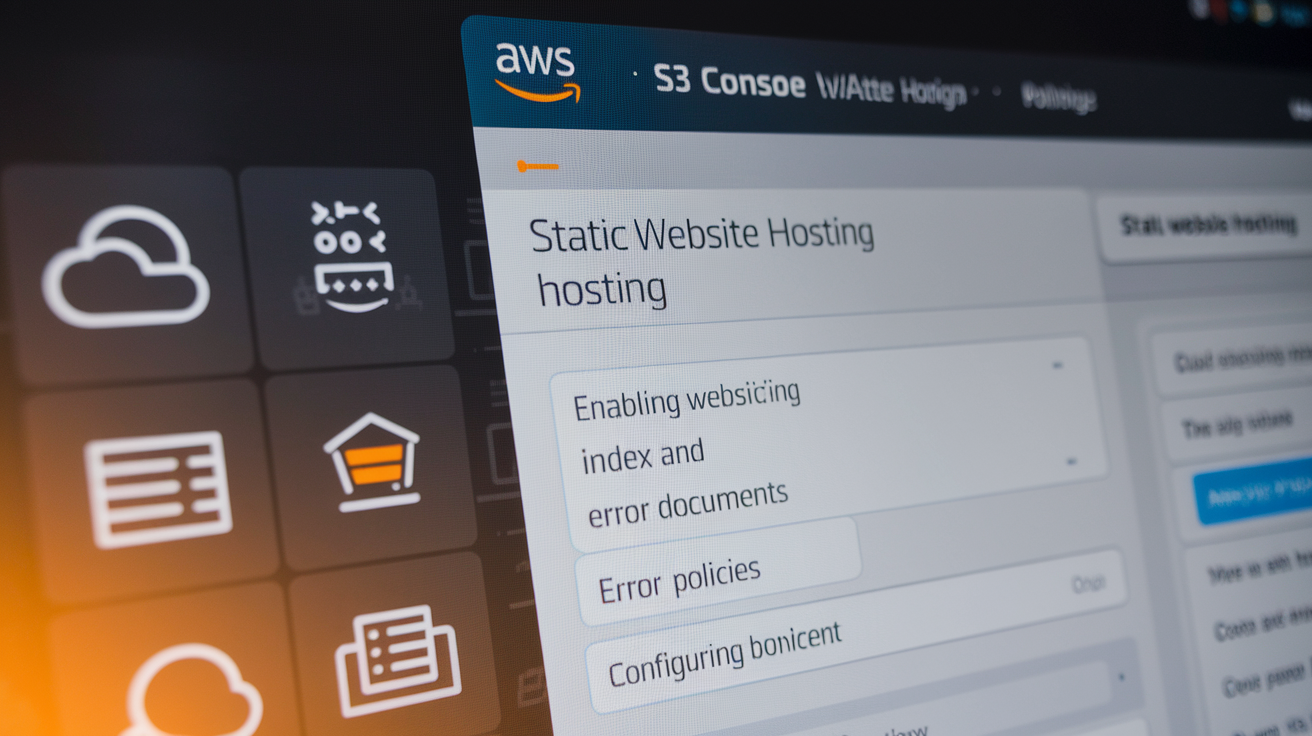Have you ever dreamed of deploying a lightning-fast, secure, and scalable web application without the headache of managing servers? 🚀 Welcome to the world of serverless architecture, where AWS (Amazon Web Services) reigns supreme!
In this guide, we’ll embark on an exciting journey to deploy a full-stack serverless app using AWS’s powerful trio: S3 for hosting, CloudFront for speed, and WAF for protection. Whether you’re a seasoned developer or just starting out, you’ll discover how these services work in harmony to create a robust, high-performance web application that can handle millions of users with ease. 💪
Ready to revolutionize your app deployment strategy? Let’s dive into the key components of our serverless solution, starting with understanding the fundamentals of serverless architecture and how it can transform your development process. Buckle up as we explore AWS S3 for static website hosting, harness the global power of CloudFront for content delivery, and fortify our app with WAF’s advanced security features. 🛡️
Understanding Serverless Architecture

Benefits of serverless applications
Serverless architecture offers numerous advantages for modern application development:
- Cost-efficiency: Pay only for actual compute time used
- Scalability: Automatic scaling based on demand
- Reduced operational overhead: No server management required
- Faster time-to-market: Focus on code, not infrastructure
| Benefit | Traditional Architecture | Serverless Architecture |
|---|---|---|
| Scaling | Manual or pre-configured | Automatic and seamless |
| Costs | Fixed, regardless of usage | Pay-per-execution model |
| Maintenance | Regular server updates | Managed by cloud provider |
AWS serverless ecosystem
AWS provides a comprehensive suite of serverless services:
- Lambda: Function-as-a-Service (FaaS) for running code
- API Gateway: Managed API creation and management
- DynamoDB: Serverless NoSQL database
- SNS: Pub/sub messaging and mobile notifications
- SQS: Fully managed message queuing service
Key components: S3, CloudFront, and WAF
-
Amazon S3 (Simple Storage Service):
- Object storage for static website hosting
- Scalable and highly available
- Integrates seamlessly with other AWS services
-
CloudFront:
- Content Delivery Network (CDN) for global distribution
- Reduces latency and improves performance
- Supports both static and dynamic content
-
Web Application Firewall (WAF):
- Protects web applications from common exploits
- Customizable rules for specific security needs
- Integrates with CloudFront for edge-level protection
These components work together to create a robust, scalable, and secure serverless architecture for full-stack applications. By leveraging S3 for hosting, CloudFront for content delivery, and WAF for security, developers can build high-performance applications with minimal infrastructure management.
Setting Up AWS S3 for Static Website Hosting

Creating an S3 bucket
To begin setting up your static website hosting on AWS S3, you’ll need to create a new S3 bucket. Follow these steps:
- Log in to the AWS Management Console
- Navigate to the S3 service
- Click “Create bucket”
- Choose a unique name for your bucket
- Select the appropriate region
- Configure bucket settings (versioning, encryption, etc.)
| Setting | Recommendation |
|---|---|
| Versioning | Enable for content management |
| Encryption | Enable server-side encryption |
| Public access | Block all public access (for now) |
Configuring bucket policies
After creating your S3 bucket, you’ll need to configure the bucket policy to allow public read access:
- Select your newly created bucket
- Go to the “Permissions” tab
- Click “Edit” under “Bucket policy”
- Add a policy allowing public read access
Here’s a sample bucket policy:
{
"Version": "2012-10-17",
"Statement": [
{
"Sid": "PublicReadGetObject",
"Effect": "Allow",
"Principal": "*",
"Action": "s3:GetObject",
"Resource": "arn:aws:s3:::your-bucket-name/*"
}
]
}
Uploading website files
With your bucket created and configured, it’s time to upload your website files:
- Use the AWS Management Console, AWS CLI, or SDK
- Maintain your website’s directory structure
- Set appropriate content types for each file
Enabling static website hosting
Finally, enable static website hosting for your S3 bucket:
- Go to the “Properties” tab of your bucket
- Scroll down to “Static website hosting”
- Click “Edit” and enable static website hosting
- Specify your index and error documents
- Save the changes and note the endpoint URL
Now that your S3 bucket is set up for static website hosting, we’ll move on to implementing AWS CloudFront for content delivery, which will significantly improve your website’s performance and global reach.
Implementing AWS CloudFront for Content Delivery

Creating a CloudFront distribution
To create a CloudFront distribution, navigate to the AWS CloudFront console and click “Create Distribution.” Select your S3 bucket as the origin domain and configure the default cache behavior. Choose the security settings, including HTTPS options, and select the price class that suits your needs.
Configuring origin and behavior settings
Optimize your CloudFront distribution by fine-tuning origin and behavior settings:
-
Origin settings:
- Origin protocol policy
- Origin path
- Origin timeout
-
Behavior settings:
- Viewer protocol policy
- Allowed HTTP methods
- Caching options
| Setting | Recommended Configuration |
|---|---|
| Viewer Protocol Policy | Redirect HTTP to HTTPS |
| Allowed HTTP Methods | GET, HEAD, OPTIONS |
| Cache Policy | CachingOptimized |
Setting up custom domain names
To use a custom domain with CloudFront:
- Register your domain in Route 53 or your preferred registrar
- Request an SSL certificate through AWS Certificate Manager
- Add an alternate domain name to your CloudFront distribution
- Create a CNAME record in your DNS settings pointing to the CloudFront distribution
Optimizing caching strategies
Implement effective caching strategies to improve performance and reduce origin load:
- Use cache policies to control caching behavior
- Implement versioning for static assets
- Utilize origin request policies to customize cache keys
- Configure TTL settings for different content types
By leveraging CloudFront’s global network and optimizing your distribution settings, you’ll significantly enhance your serverless app’s performance and user experience. Next, we’ll explore how to secure your application using AWS WAF.
Securing Your App with AWS WAF

Understanding common web vulnerabilities
Web applications face numerous security threats. Here are some of the most common vulnerabilities:
- SQL Injection
- Cross-Site Scripting (XSS)
- Cross-Site Request Forgery (CSRF)
- Distributed Denial of Service (DDoS)
- Man-in-the-Middle (MitM) attacks
| Vulnerability | Description | Mitigation |
|---|---|---|
| SQL Injection | Malicious SQL statements inserted into application queries | Input validation, prepared statements |
| XSS | Malicious scripts injected into trusted websites | Output encoding, Content Security Policy |
| CSRF | Unauthorized commands from a trusted user | Anti-CSRF tokens, SameSite cookies |
| DDoS | Overwhelming servers with traffic | Rate limiting, traffic analysis |
| MitM | Intercepting communication between two parties | SSL/TLS encryption, certificate pinning |
Creating WAF rules and conditions
AWS WAF allows you to create custom rules to protect against these vulnerabilities. Some key rules include:
- Rate-based rules to prevent DDoS attacks
- SQL injection prevention rules
- XSS detection rules
- Geo-blocking rules for specific regions
Integrating WAF with CloudFront
Integrating WAF with CloudFront is straightforward:
- Create a WAF Web ACL
- Configure rules and conditions
- Associate the Web ACL with your CloudFront distribution
This integration ensures that all requests passing through CloudFront are inspected and filtered by WAF before reaching your application.
Monitoring and fine-tuning security measures
Continuous monitoring is crucial for maintaining robust security. AWS provides tools like CloudWatch and WAF logs to help you analyze traffic patterns and detect potential threats. Regularly review these logs and adjust your WAF rules as needed to stay ahead of evolving security threats.
Deploying Your Full-Stack Serverless App

A. Preparing your application code
Before deploying your full-stack serverless app on AWS, it’s crucial to properly prepare your application code. This involves organizing your project structure, optimizing assets, and ensuring compatibility with serverless architecture.
-
Project structure:
- Separate frontend and backend code
- Use a build system (e.g., Webpack, Rollup) for frontend assets
- Organize backend functions into logical modules
-
Code optimization:
- Minify and compress static assets
- Implement code splitting for improved load times
- Remove unused dependencies and dead code
Here’s a sample project structure for a serverless full-stack app:
| project-root/
|-- frontend/
| |-- src/
| |-- public/
| |-- package.json
| |-- build/
|-- backend/
| |-- functions/
| |-- package.json
|-- infrastructure/
| |-- cloudformation.yaml
|-- README.md
B. Configuring AWS services
To deploy your serverless app, you’ll need to configure the necessary AWS services. This includes setting up S3 for hosting, CloudFront for content delivery, and WAF for security.
-
S3 configuration:
- Create a new S3 bucket
- Enable static website hosting
- Set appropriate bucket policies
-
CloudFront setup:
- Create a new distribution
- Configure origin settings
- Set up caching behaviors
-
WAF implementation:
- Create a web ACL
- Define security rules
- Associate with CloudFront distribution
| Service | Purpose | Key Configuration |
|---|---|---|
| S3 | Static hosting | Website hosting, bucket policy |
| CloudFront | Content delivery | Origin settings, caching behaviors |
| WAF | Security | Web ACL, security rules |
C. Testing the deployment
After configuring the AWS services, it’s essential to thoroughly test your deployment to ensure everything is working as expected.
Now that we have our services set up, let’s go through the testing process:
-
Verify S3 hosting:
- Access the S3 website endpoint directly
- Check if static assets are being served correctly
-
Test CloudFront distribution:
- Access your app through the CloudFront URL
- Verify that content is being cached and delivered efficiently
-
Validate WAF protection:
- Simulate common attack patterns
- Ensure WAF rules are blocking malicious requests
-
End-to-end testing:
- Test all app functionalities
- Verify API integrations and data flow
D. Troubleshooting common issues
Even with careful preparation and testing, you may encounter issues during deployment. Here are some common problems and their solutions:
-
S3 access denied:
- Review bucket policies and permissions
- Ensure proper CORS configuration
-
CloudFront caching issues:
- Check cache settings and TTL values
- Use cache invalidation when necessary
-
WAF false positives:
- Fine-tune WAF rules
- Implement IP whitelisting for trusted sources
-
API Gateway errors:
- Verify Lambda function permissions
- Check API Gateway integration settings
By following these steps and addressing common issues, you’ll be well-prepared to deploy and maintain your full-stack serverless app on AWS. Next, we’ll explore ways to optimize performance and manage costs effectively.
Optimizing Performance and Costs
Analyzing CloudFront metrics
To ensure optimal performance of your serverless app, it’s crucial to regularly analyze CloudFront metrics. AWS provides a comprehensive set of metrics that can help you identify bottlenecks and areas for improvement.
Key metrics to monitor include:
- Cache Hit Rate
- Origin Latency
- Error Rates
- Total Requests
| Metric | Description | Optimization Goal |
|---|---|---|
| Cache Hit Rate | Percentage of requests served from CloudFront cache | Increase to reduce origin load |
| Origin Latency | Time taken for CloudFront to retrieve content from origin | Decrease for faster content delivery |
| Error Rates | Percentage of requests resulting in errors | Minimize for better user experience |
| Total Requests | Number of requests received by CloudFront | Monitor for capacity planning |
Implementing S3 lifecycle policies
S3 lifecycle policies can significantly reduce storage costs and improve performance. These policies allow you to automatically transition objects between storage classes or delete them based on predefined rules.
Best practices for S3 lifecycle policies:
- Move infrequently accessed data to cheaper storage classes
- Delete outdated or unnecessary objects
- Implement versioning with lifecycle rules to manage old versions
Optimizing WAF rule processing
Efficient WAF rule processing is essential for maintaining security without compromising performance. To optimize WAF:
- Prioritize rules based on importance and frequency of matches
- Use rate-based rules for DDoS protection
- Regularly review and update rules to address new threats
Leveraging AWS cost management tools
AWS offers various tools to help manage and optimize costs:
- AWS Cost Explorer: Visualize and analyze your AWS spending
- AWS Budgets: Set custom budgets and receive alerts
- AWS Trusted Advisor: Get recommendations for cost optimization
By leveraging these tools and implementing the strategies discussed, you can significantly improve the performance and cost-efficiency of your serverless app on AWS.
Deploying a full-stack serverless app on AWS offers a powerful combination of scalability, performance, and security. By leveraging S3 for hosting, CloudFront for content delivery, and WAF for protection, developers can create robust applications that are both cost-effective and efficient. This approach eliminates the need for server management, allowing teams to focus on building and improving their core application functionality.
As you embark on your serverless journey, remember that continuous optimization is key. Regularly monitor your app’s performance, costs, and security posture to ensure you’re making the most of AWS’s serverless ecosystem. With the right implementation and ongoing maintenance, your serverless application can deliver exceptional user experiences while keeping operational overhead to a minimum. Take the leap into serverless architecture and unlock the full potential of your web applications in the cloud.




















